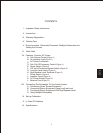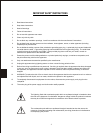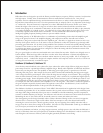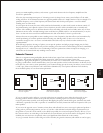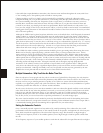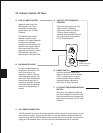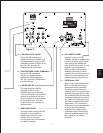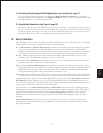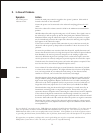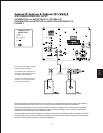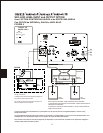
is that while bass output diminishes somewhat, it also becomes more uniform throughout the room, with fewer
of the “standing waves” that produce peaks and nulls at various points.
Chances are things won't be so simple, so the best method for positioning a subwoofer, although a rather
undignified-looking one, is to put the subwoofer in your listening chair, then play music with lots of bass through
the system something with steady low frequencies (such as organ music) or continuous test tones, not movie
material. Move around the room and note where the bass sounds best; if you place the subwoofer there and
yourself in your chair, you should get the same bass performance. Bear in mind that the test only works if you
have your ears as high off the floor as the subwoofer will be, so don't be afraid to crawl around. A recommended
starting point for the placement of this subwoofer would be in either of the front corners of the room (on either
side of the main speakers).
Although the CHS212 can be placed anywhere within the room, as described above, it will frequently be mounted
within a cabinet or “wall unit” intended for hiding away the components of your home theater. When cabinet
mounted a few extra details must be attended too. The woofers on the CHS212 are placed on the front face and
the underneath so that they are closest to a “sonic exit” of the cabinet. The cabinet may have a front door with a
grille (cloth or latticework). It may also have a solid front as long as a substantial slot (typically 4” by 17” or more)
is near the woofers. The best location for this slot would be at floor level in line with the area to the front of the
cabinet and between the woofer cabinet legs. An inch or so of space between the front firing woofer and the
cabinet front will create enough of a channel for the bass to get down to a floor level slot.
If the CHS212 is within a cabinet, special attention should be given to preventing rattles from strong bass tones.
Rattles can be found by repeatedly playing a selection with a variety of strong sustained bass tones. Action
movies with a lot of LFE (low frequency effects) content can be helpful as well. With the other speakers down,
turn the level up to the highest level likely to be encountered and listen closely for rattles. If they occur, find the
cabinet panels that are causing the rattle. Usually a joint or contact area between two surfaces is vibrating and this
is the cause of the rattle. Some foam tape or the commonly available self adhesive felt discs, placed between the
offending surfaces will damp the rattle. Absorptive material, such as fiberglass, may help damp internal
resonances of the cabinet's cavities, but it will need to be quite thick to have significant effect. Filling the full
cavity above the subwoofer can give a significant improvement, just be sure that the woofers and their bass exit
path are not obstructed. Although it normally runs cool, be especially sure that any heat generated by the rear
amplifier has an exit path and that no materials are in contact with its metal surfaces.
Multiple Subwoofers—Why Two Subs Are Better Than One
Since the objective of most people who buy subs is to make sure of plentiful low frequencies, the only situation
most of us will run into that makes subwoofer placement really difficult is the factor we all fear—the “bad” room
that just won't let you get satisfying amounts or quality of bass. There are rooms with troublesome dimensions,
especially as you approach a perfect cube (with a closed door). There is unlikely to be any combination of speaker
and listener position that will be free of obvious acoustic anomalies.
In such a case, the best way to iron out those anomalies is with two subwoofers, placed carefully to work with each
other. This can also be true when the problem is too much, or too uneven, bass. The overall system needs all the
help it can get, and that often means the use of two subwoofers, each one of which corrects for the acoustic
problems excited by the other. For excellent results from this solution, the two subs don't have to be identical. It
may be fine, in fact, to use two lesser subs to equal the performance of one with stronger specs.
The same “crawl around the room” method as previously described should be used for determining the location
of the second subwoofer, except in this instance one is listening for the minimum amount of bass output. This is
a recommended starting point for determining the best placement for your subwoofer(s).
Setting the Subwoofer Controls
Once a reasonably smooth response has been achieved by careful positioning of the subwoofers, the overall
performance can be fine-tuned by means of the controls found on the speaker. An important one is the low-pass
filter, which controls the upper limit of the subwoofer's frequency range. This should be set high enough to
overlap the low frequency cutoff of the satellite speakers, but not high enough to localize specific sounds from
the sub.
If the frequency response of your satellite speakers is such that the subwoofer's low-pass filter must be set higher
8





